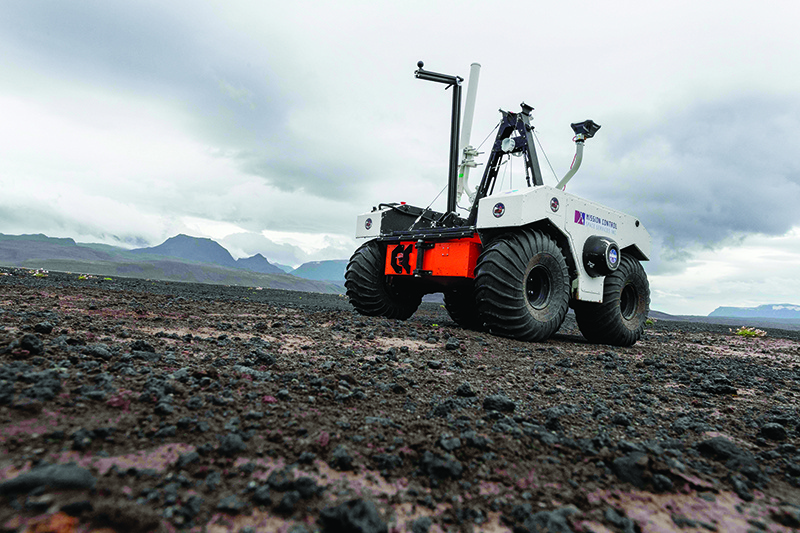
LAMBAHRAUN LAVA
FIELD, Iceland: To prepare for the next mission to Mars in 2020, NASA has taken
to the lava fields of Iceland to get its new robotic space explorer ready for
the job. With its black basalt sand, wind-swept dunes and craggy peaks, the
Lambahraun lava field at the foot of Iceland's second biggest glacier,
Langjokull, was chosen as a stand-in for the Red Planet's surface. For three
weeks, 15 scientists and engineers sent by the US space agency descended on the
site, 100 km from the capital, Reykjavik, last month to develop a prototype.
It will aim to
continue the work of the "Curiosity" rover, which has been exploring
Mars since 2012 in search of signs of ancient life and making preparations for
human exploration. Experts say that Iceland, a volcanic island in the middle of
the North Atlantic, is in many ways reminiscent of the fourth planet from the
Sun. "It's a very good analogue for Mars exploration and learning how to
drive Mars rovers," said Adam Deslauriers, manager of space and education,
at Canada's Mission Control Space Services. The company has been commissioned
by NASA to test a rover prototype as part of the SAND-E (Semi-Autonomous
Navigation for Detrital Environments) project.
The prototype is
a small, electric vehicle with white panels and an orange chassis. It has a
four-wheel drive propelled by two motors and is powered by 12 small car
batteries stacked inside. "This rover we have... (is) basically
indestructible," Deslauriers told AFP. "The rovers that we have on
Mars and the Moon would be a lot more sensitive to the environment and
conditions of Iceland. "A Moon rover is completely unprepared for
rain," he added, just as a rain shower swept in.
Equipped with
sensors, a computer, a dual-lens camera and controlled remotely, the rover
moves its approximately 570 kg at a leisurely speed of about 20 cm per second.
The speed needs to be slow to enable the rover to collect data and imagery
properly, Mark Vandermeulen, a robotics engineer at Mission Control Space
Services, said. The meager pace on the lava field is still two to four times
faster than the speed it will be driving at its extraterrestrial destination.
Utilising its
sensors and camera, the rover gathers and classifies data from its environment
and sends back the findings to the engineers' trailer. The engineers then
package the data and forward it to a tent where the scientists are huddled, to
simulate how the data would be sent from Mars to Earth. The rover exploring
Iceland is just a prototype for the one that will be going to Mars next year.
That one, which has yet to be named, will also be able to collect samples and
store them in tubes to be brought back to Earth by future missions. As the
prototype isn't capable of doing this, researchers walk to the area studied,
armed with radiometers and other equipment, to collect all the data samples
that the finished rover would be able to do.
The sites are
selected to study how the chemical composition and physical properties of the
sand and rocks change as they move from the glacier to a nearby river. Before
Mars became an inhospitable frozen desert with an average temperature of minus
63 degrees C, scientists believe that the planet shared many of the
characteristics of the subarctic island. "The mineralogy in Iceland is
very similar to what we would find on Mars," Ryan Ewing, associate
professor of geology at Texas A&M University, said.
In particular,
Ewing referred to minerals such as olivine and pyroxenes, both dark so-called
mafic rocks, which have also been found on Mars. "In addition to that, we
don't have much vegetation, it's cold and we have some of the environments like
sand dunes and rivers and glaciers that Mars has evidence of in the past,"
Ewing said. Iceland has previously been used as a training ground for NASA
missions.
During the Apollo
mission years, 32 astronauts in the mid-1960s received geological training in
the Askja lava fields and near the Krafla crater in the north of the country.
The setting allows NASA to test equipment and procedures, as well as the people
performing them, in extreme environments while remaining on terra firma.
Mission Control says it is planning to return to Iceland next summer before the
launch of the next Mars rover mission, scheduled between July 17 and Aug 5,
2020. - AFP










